A crusty, no-knead, sourdough bread with a delightfully soft texture and deliciously tangy flavor. The dough is mixed one day and baked the next, giving it an elevated taste and texture.
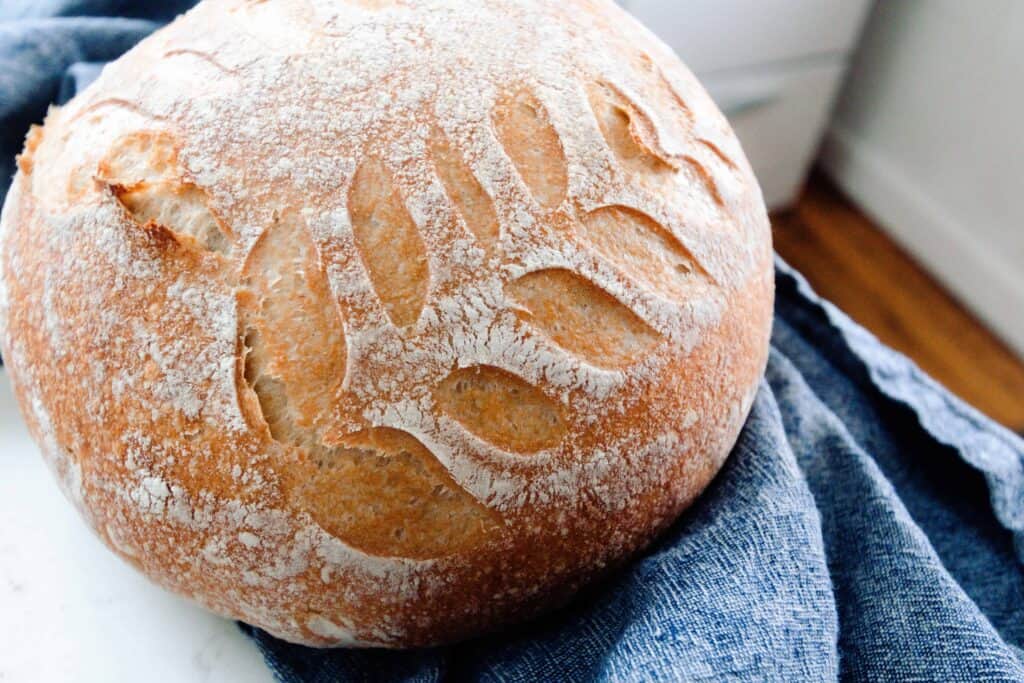
Crusty loaves of sourdough bread are an absolute staple in our house. This is an art I continue to work at mastering, but I also think of it as a hobby. I enjoy working on my sourdough recipes, fine tuning and perfecting them.
I’m hoping this will also become a passion for my children one day, as they reflect back on the memories of fresh bread and time spent in the kitchen. How fortunate to find a hobby kind of joy in a simple, everyday kind of task!
Learning makes me happy, and learning how to make the perfect loaf and mastering beautiful designs can be incredibly satisfying. I continue to find that the extra special attention to detail makes all the difference, especially with sourdough.
See, sourdough can be fickle. Sometimes a loaf doesn’t turn out just right. Don’t get me wrong, we still eat it.
We might turn it into a breakfast Strata, stuffing, or cut it in half and make pizza bread, but we still eat it.
After experimenting for weeks to create the perfect, artisan-style, no-knead bread, I finally feel like I nailed it.
This process and recipe has given me consistently good loaves, so that’s why I’m excited to share it!
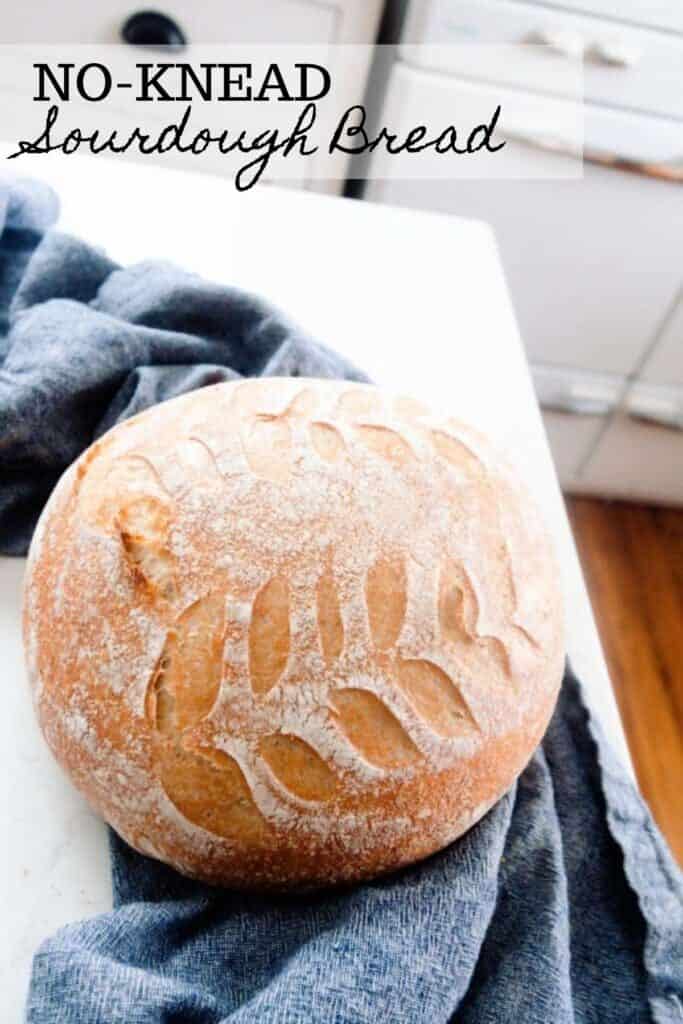
What is sourdough bread?
Sourdough bread is a fermented bread that uses natural wild yeast to rise, rather than relying on commercial yeast.
It is a healthier choice, plus many people who are sensitive to gluten (not celiac) can tolerate sourdough products, due to the fermentation of the grains.
Phytic acid (that is naturally present in wheat), which is an anti-nutrient that blocks absorption of the nutrients found in wheat, gets broken down during the fermentation process. This breakdown, in turn, makes the nutrients more available for your body to absorb.
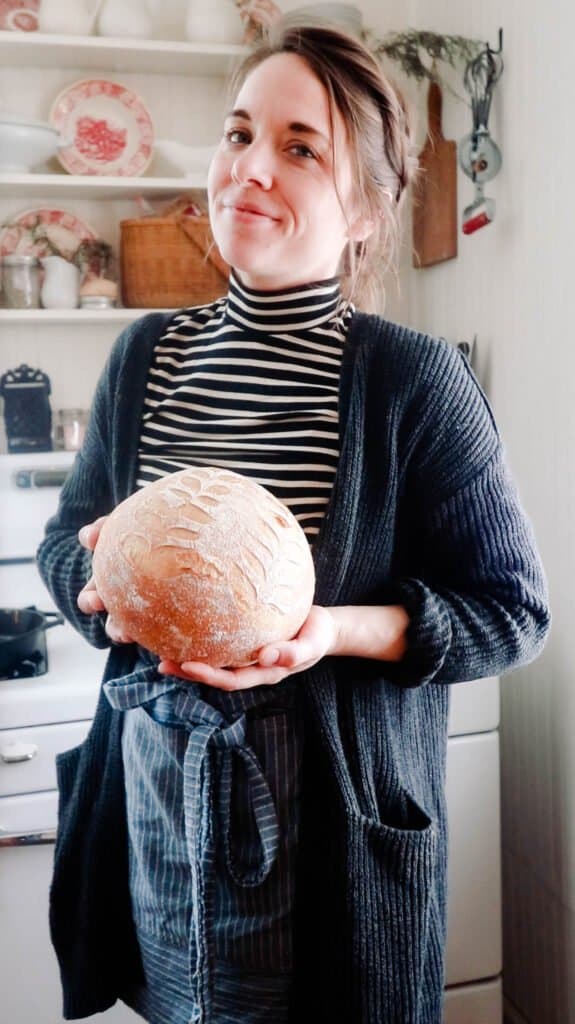
How do you make a sourdough starter?
Creating a sourdough starter is actually pretty simple. It is the process of mixing water and flour together for multiple days until yeasts are captured and the flour bubbles. You can find the tutorial on how to make a sourdough starter here.
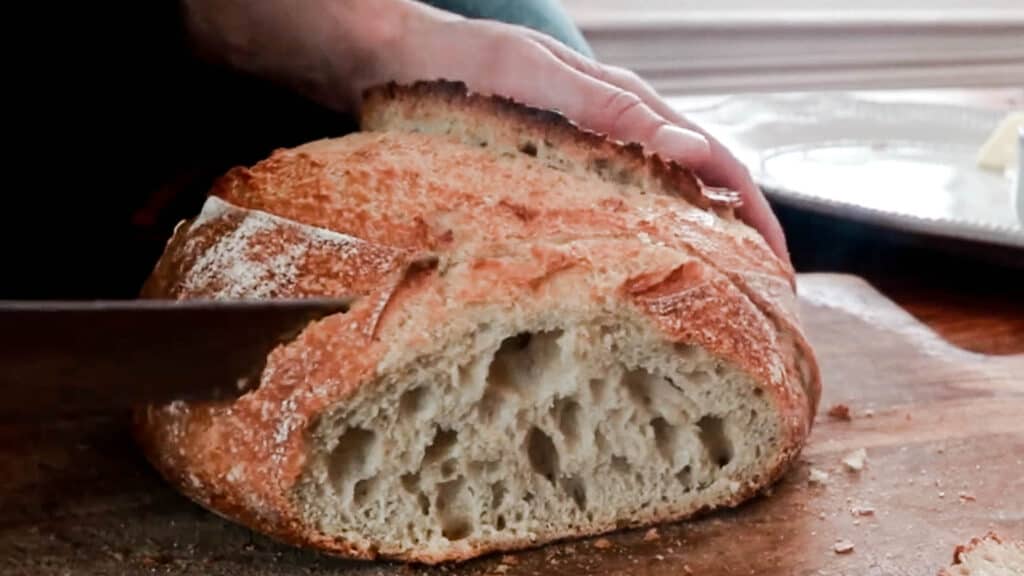
Is it necessary to knead sourdough?
Not necessarily. The act of kneading is supposed to help create gluten formation in the bread, which can then help create a good texture and air pockets in the bread. But no-knead sourdough bread uses other methods to develop the gluten.
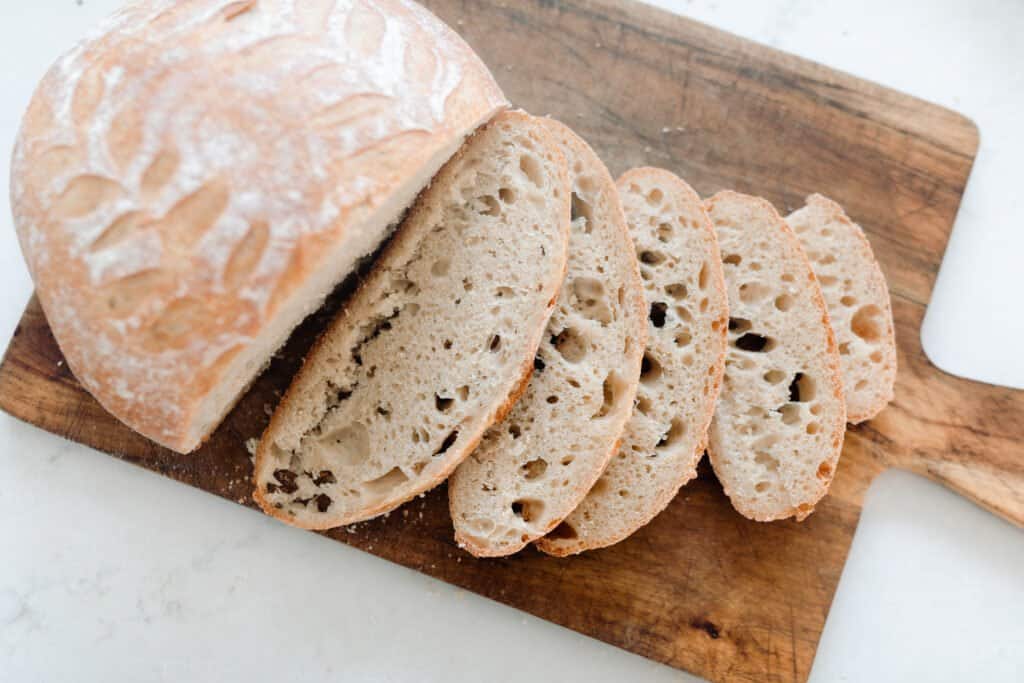
How does no-knead sourdough work?
In no-knead versions, the gluten develops during the stretching and folding process, as well as during the bulk fermentation process, which helps create those glorious air pockets.
This post contains affiliate links, which means I make a small commission at no extra cost to you. See my full disclosure here.
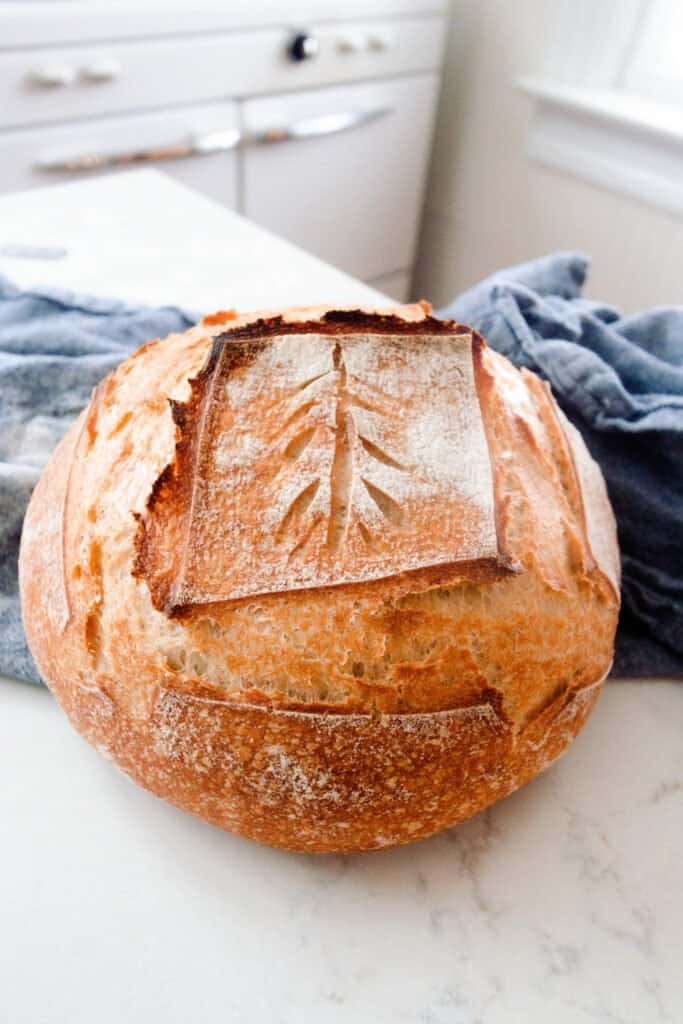
Tips For Success:
- You will need an active sourdough starter to create a well-risen bread. Check out how to make a sourdough starter and how to care for one.
- Cover the dough with a damp towel, beeswax wrap, or plastic wrap to ensure that an unpleasant crust doesn’t develop.
- The amount of time it takes for your dough to double can be determined by many environmental factors, such as the temperature in your home, the maturity of your starter, and the hydration status of the loaf.
- The most accurate way to get the best loaves of bread each time is to measure your ingredients with a kitchen scale.
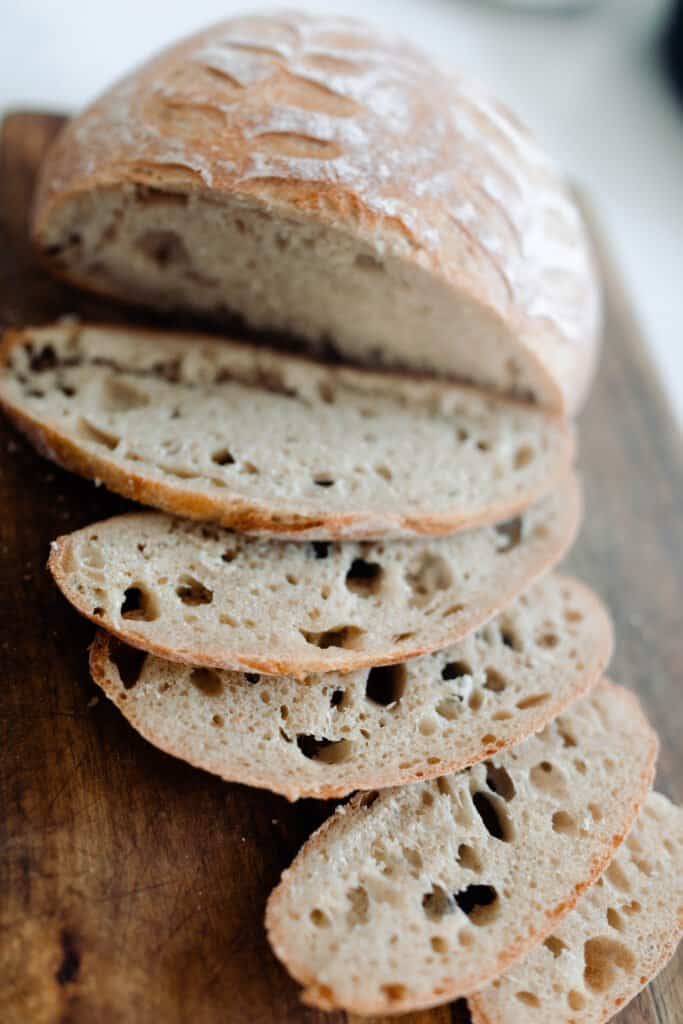
Tools you may need to make this recipe:
Large bowl
Kitchen scale
Banneton (optional)
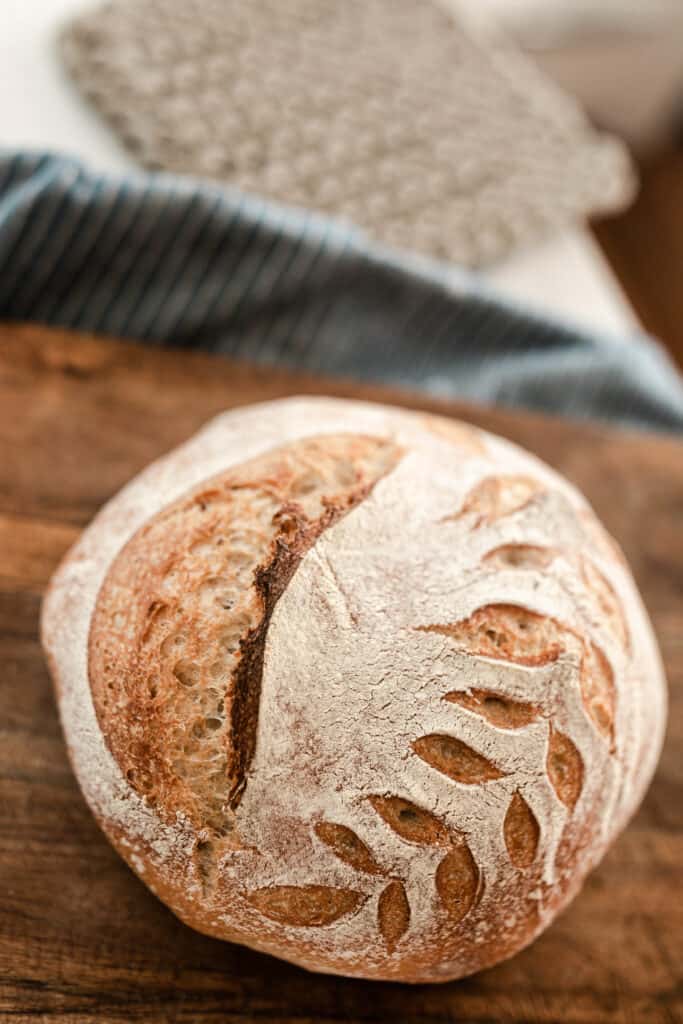
How To Make No-Knead Sourdough Bread
Feed a sourdough starter 4-12 hours before starting the bread, ensuring it is active and bubbly.
Combine warm water and flour. Allow to rest for 30 minutes for the water to hydrate the flour. This process is called autolyse.
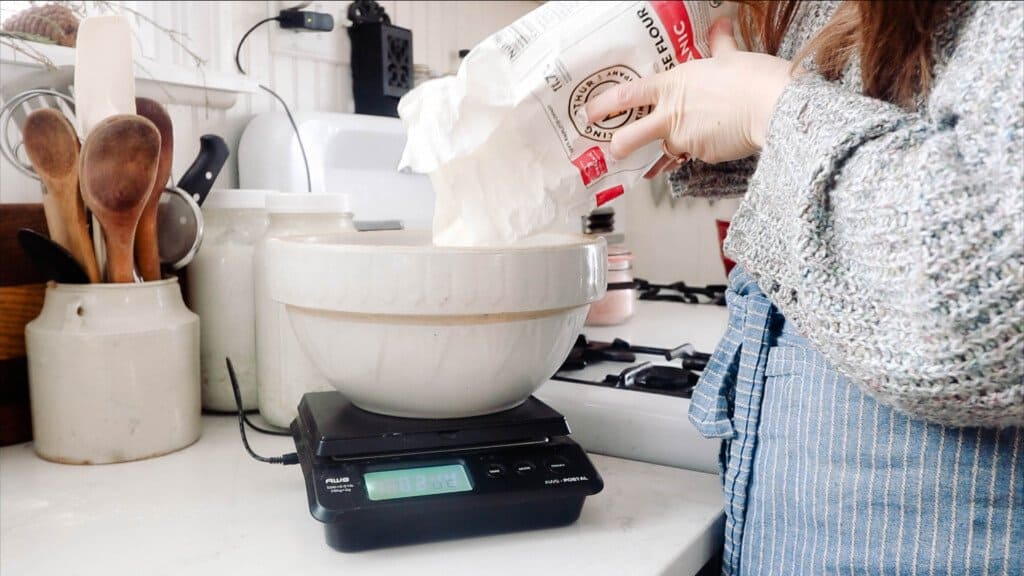
Add sourdough starter. Dimple in with wet hand.
Sprinkle salt on top.
Mix the dough with your hands for about 5 minutes to bring the dough together. Cover with damp towel or plastic wrap while resting.
Cover with plastic wrap or damp towel and let rest for 30 minutes.
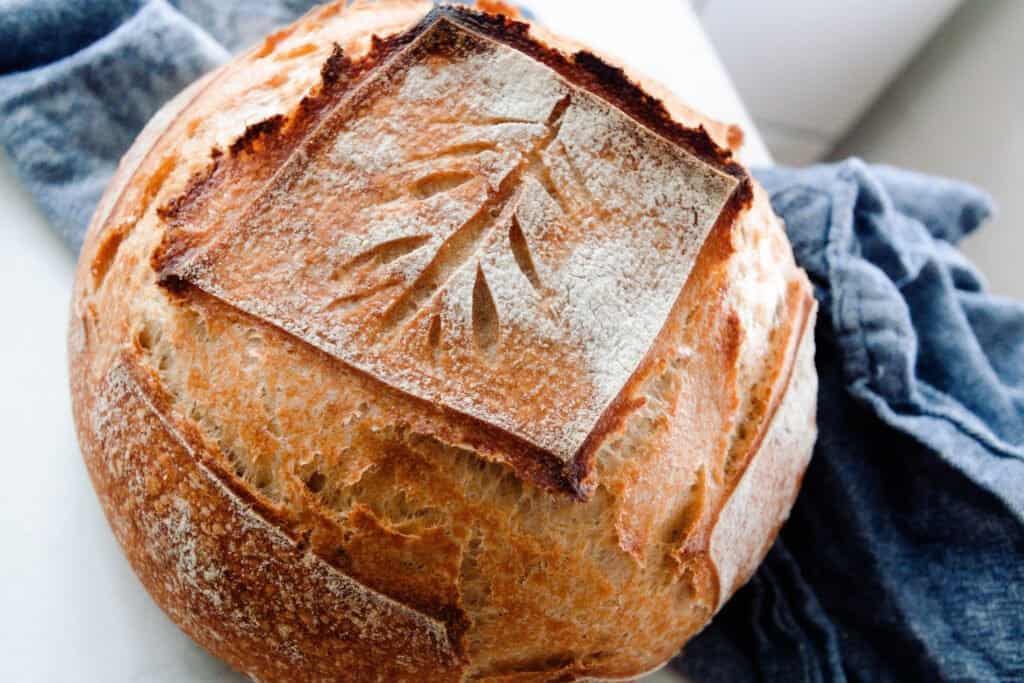
Stretch And Fold
To develop the gluten and obtain a nice rise, you will want to do 6 rounds of stretching and folding.
While the dough is in the bowl, grab the edge and the dough firmly and pull up, stretching it upwards. Then place the dough in your hands into the center. Turn the bowl about a quarter turn and do this stretch and fold again, and again one to two more times. This is considered one stretch and fold round. Repeat according to the directions below. Dip your hand in water if the dough is too sticky.
First 3 stretch and folds – every 15 minutes.
Last 3 stretch and folds – every 30 minutes.
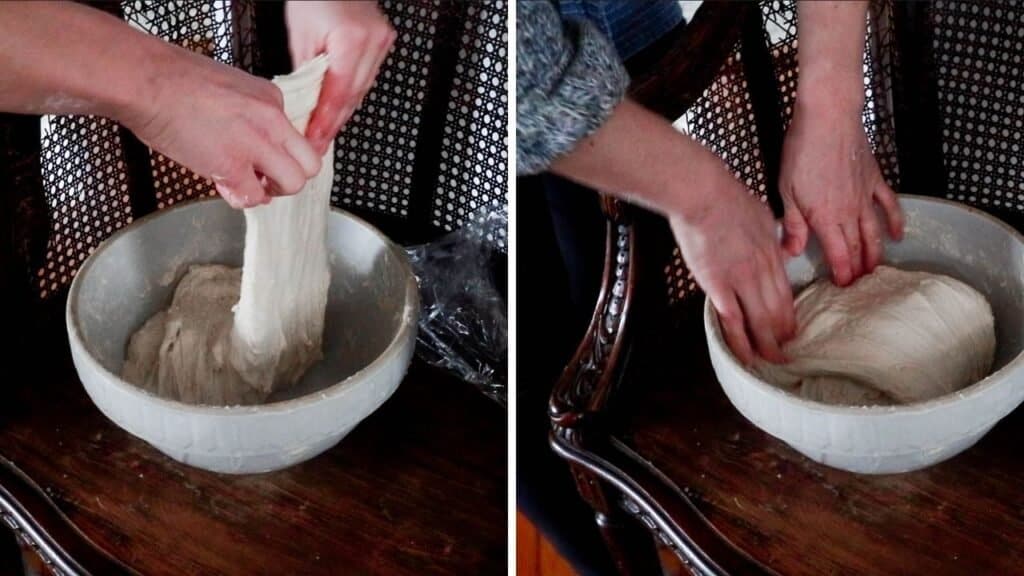
Cover with a wet towel or plastic wrap and allow the dough to bulk-ferment until doubled.
The timing for this will vary depending on temperature, hydration, and maturity of your starter. You could also let this step go longer for further health benefits. I do this in the morning and then let it go all day.
When it’s done, there will be bubbles all over the surface.
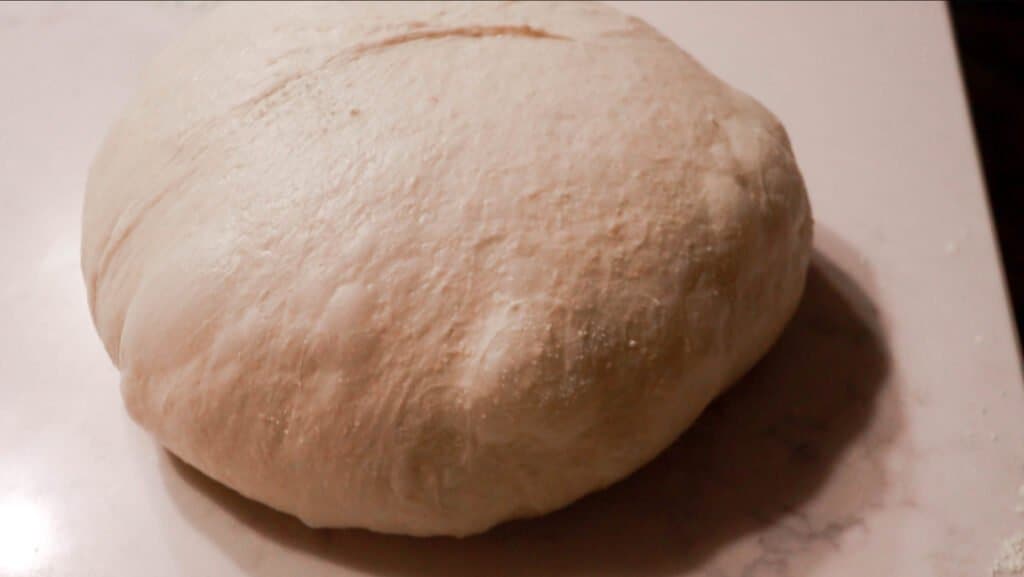
Split the dough in half down the middle with a dough scraper. Be really careful not to break any of those precious bubbles.
Shape into a ball by gently spinning it toward you.
Set out 15-20 minutes uncovered. This allows the surface to develop a skin, so that it doesn’t stick to the tea towel during the overnight rise.
Turn over and shape. I do this by folding the two sides over to meet in the middle, and then the other two sides.
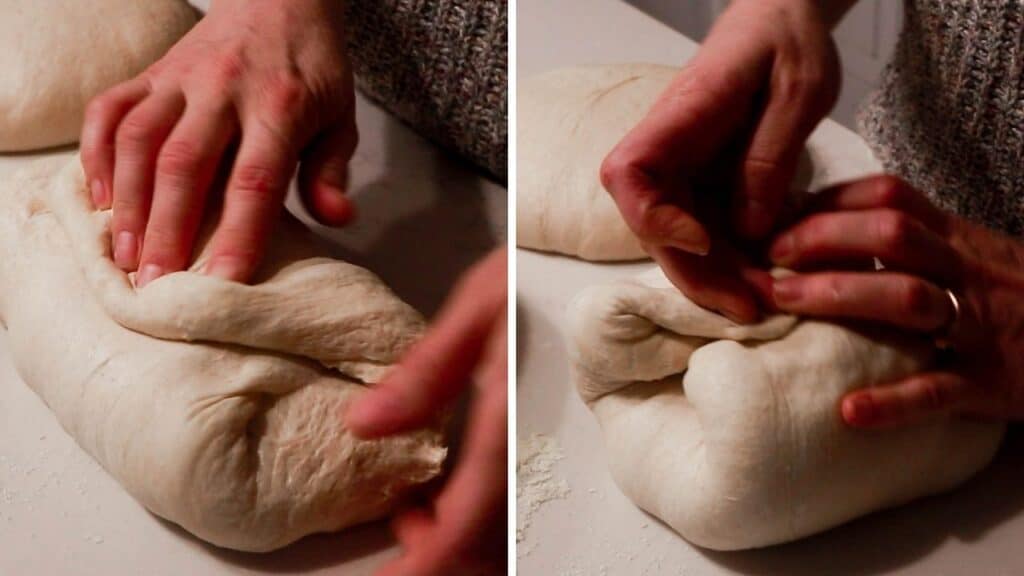
Repeat with the other half of the dough. This recipe yields two loaves.
Transfer to flour banneton or bowl with tea towel, seam side up. Cover with plastic and proof 12-15 hours in refrigerator.
Bake
Preheat dutch oven to 500 degrees for 1 hour.
Remove dough from the fridge immediately before scoring and baking.
Dust with flour on top to make the scoring pattern stand out more.
Score with a razor.
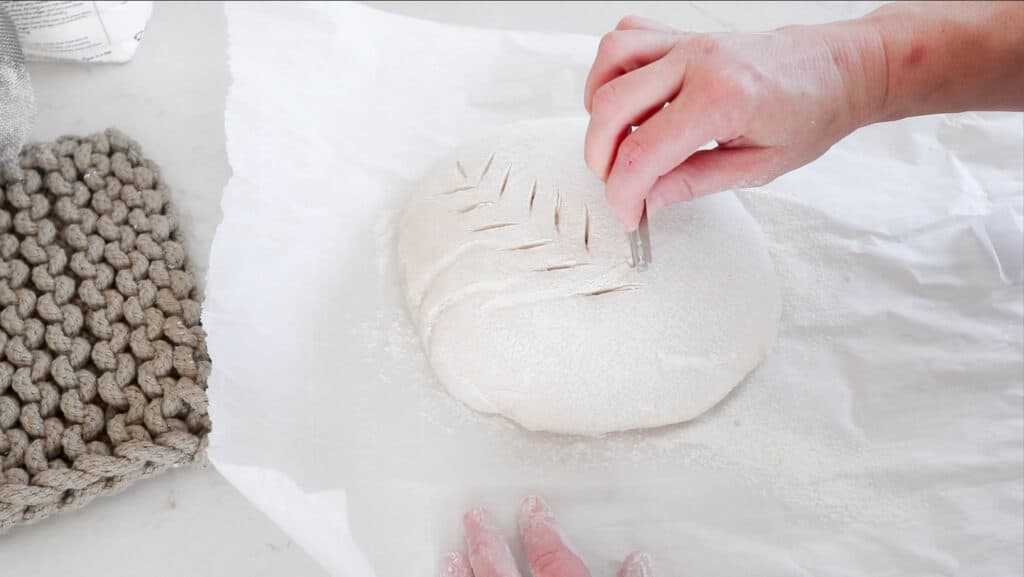
Add a little flour to the bottom of the dutch oven (or parchment paper) and transfer dough to it.
Bake for 20 minutes at 500 with lid on.
Take lid off, turn the oven temperature down to 475, and bake an additional 25 minutes or until browned.
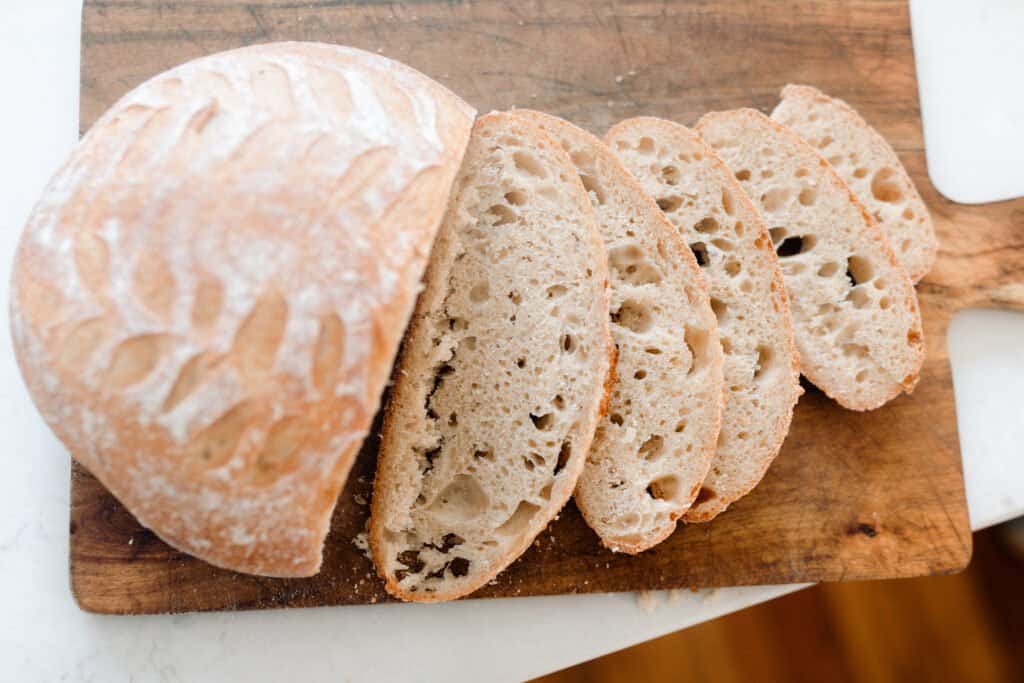
Tips for making your sourdough bread pretty
- Don’t skip the long rising time in the refrigerator. Bread dough takes forever to rise in the refrigerator, but this chilling process does make the final scoring pattern prettier. I’ve never had success with a beautiful scoring design when skipping this step.
- Dust a bit of flour over the surface before scoring. This will allow the design to stand out better.
- Use a razor. I know it’s tempting to just grab a sharp knife to score your bread, but proper bread scoring razors do yield a more beautiful result.
- Do an online image search for scoring patterns, and try your hand at a few tried and true designs before getting creative with your own.
- Practice, practice, practice. You will figure out just how deeply you need to cut, and how the design spreads during baking, by trying over and over again. The good news is you’re just going to eat it no matter what. We’ve eaten many an ugly loaf of bread, and they all tasted great.
Bakers Timeline For No-Knead Sourdough Bread
8 am: Feed sourdough starter with flour and water.
12 pm: If sourdough starter is mature, then proceed to creating the dough.
Combine the warm water and flour. Rest for 30 minutes.
12:30-ish pm: Add in sourdough starter and dimple in with wet hand.
Sprinkle salt on top.
Mix the dough with your hands for about 5 minutes. Cover with damp towel or plastic wrap. Rest for 30 minutes.
1:00ish pm: Stretch and fold.
First 3 stretch and folds – every 15 minutes
Last 3 stretch and folds – every 30 minutes
Cover with a wet towel or plastic wrap and allow the dough to bulk ferment until doubled.
8:00pm (may be much sooner): Split the dough in half down the middle with a dough scraper.
Shape dough.
Sit out 15-20 minutes, uncovered.
Turn over and shape.
8:30pm: Transfer to flour banneton or bowl with tea towel and cover with plastic. Place in the refrigerator for 12-15 hours.
The Next Day
9:00am: Preheat dutch oven on 500 for 1 hour.
Take dough out of fridge, dust with flour, and score.
10:00am: Bake the sourdough bread and allow to cool.
Find More Delicious Sourdough Recipes:
- Homemade Sourdough Bagels
- Sourdough Coffee Cake
- Sourdough Chocolate Chip Cookies
- Einkorn Sourdough Bread
- Sourdough Chocolate Cake
If you try this recipe and love it, I would love if you could come back and give it 5 stars! Tag me on Instagram @farmhouseonboone
No-Knead Sourdough Bread
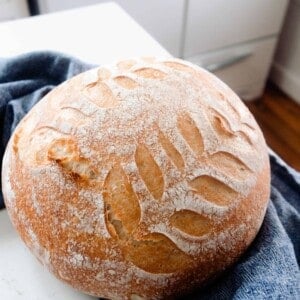
Ingredients
- 500 g unbleached all purpose
- 200 g freshly ground whole wheat
- 250 g bread flour, can omit and just add more to the unbleached all purpose
- 200 g mature starter, active and bubbly
- 650 g water
- 20 g salt
Instructions
- Feed a sourdough starter 4-12 hours before starting the bread, ensuring it is active and bubbly.
- Combine warm water and flour. Allow to rest for 30 minutes for the water to hydrate the flour.
- Add sourdough starter. Dimple in with wet hand.
- Sprinkle salt on top.
- Mix the dough with your hands for about 5 minutes to bring the dough together. Cover with damp towel or plastic wrap while resting.
- Cover with plastic wrap or damp towel and let rest for 30 minutes.
STRETCH AND FOLD
- First 3 stretch and folds – every 15 minutes.
- Last 3 stretch and folds – every 30 minutes.
- Cover with a wet towel or plastic wrap and allow the dough to bulk ferment until doubled.
- Split the dough in half down the middle with a dough scraper. Be really careful not to break any of those precious bubbles.
- Shape into a ball by gently spinning it toward you.
- Set out 15-20 minutes uncovered.
- Turn over and shape.
- Transfer to flour banneton or bowl with tea towel. Cover with plastic and proof 12-15 hours in refrigerator.
Bake
- Preheat dutch oven on 500 for 1 hour.
- Remove dough from the fridge immediately before scoring and baking.
- Dust with flour on top to make the scoring pattern stand out more.
- Score with a razor.
- Add a little flour to the bottom of the dutch oven (or parchment paper) and transfer dough to it.
- Bake for 20 minutes at 500 with lid on.
- Take lid off, turn the oven temperature down to 475 and bake an additional 25 minutes or until browned.
Notes
- Make sure your starter is very active and bubbly.
- Depending on temperature, hydration and maturity of starter will determine the amount of time it takes for it to double in size.
- To increase the health benefits you could allow the bread to ferment longer. I start the bread in the morning and then let it ferment all day.
Nutrition
Nutrition information is automatically calculated, so should only be used as an approximation.
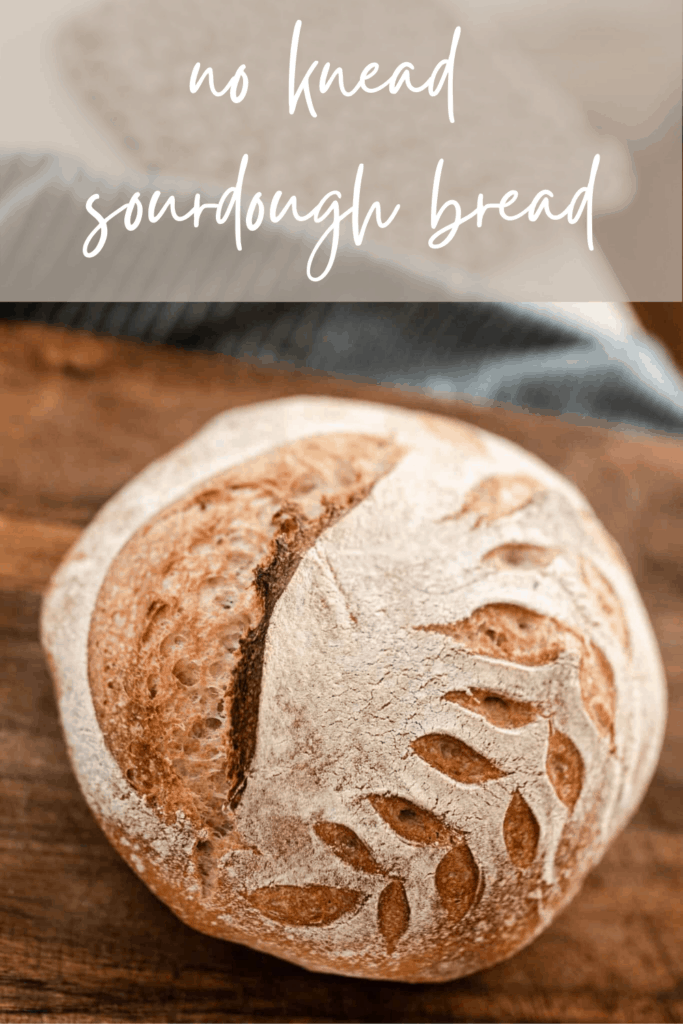
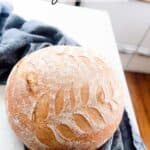
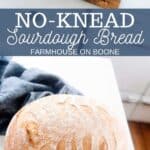
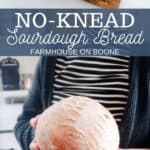
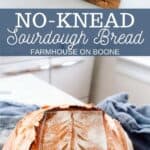
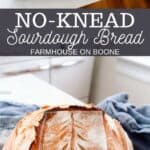
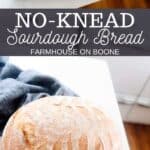
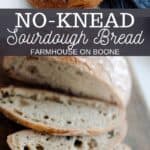
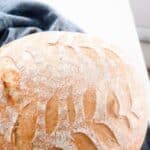
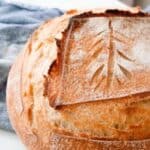
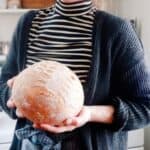
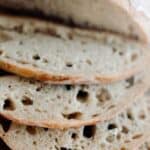










Am I able to use all All Purpose flour? If so, do I just add up the amounts of the 3 flours? Thank you.
You wouldn’t be able to just swap out all the flours for all-purpose because they absorb liquid differently than AP. If you want to use just AP flour, I would recommend using this recipe: https://www.farmhouseonboone.com/beginners-sourdough-bread-recipe
Hi Lisa, I appreciate this recipe so much! I have been able to make delicious bread. After several loaf fails my friend told me about your website and I have had success! Now I am just tweaking things to make my loaf better. For my oven, I did have to reduce the heat by 25 degrees and lengthen the lid on time a bit and shorten the lid off time . . . I have an old oven. I am writing because I have a question: Why do you use so much AP flour rather than using mostly or all bread flour? I am pretty new — I’ve been making sourdough for about 6 weeks. I live in CA and buy my AP flour from Costco and my bread flour (King Arthur) from the local grocery store. I would love to hear your thoughts on flour choice.
I’m glad you’re having success and enjoying sourdough baking. Bread flour actually has a little bit higher of a gluten content. It is still a great flour to use, but if you’re trying to minimize the gluten content, all purpose works very similarly.
Does this ingredient mean whole wheat flour?
200 g freshly ground whole wheat.
Yes
I made this a few days ago and it was amazing, so satisfying to have a successful end product!
I’m making it again today and unfortunately I added all the ingredients together, instead of doing it in stages. Any tips on how to go from here? Or should I just carry on and hope it turns out?
It should be ok! Just carry on.
Okay where to start 😀… am a totally newbie sourdough baker and today I tried this recipe (well I started yesterday lol). And I must say, this is sooooooo good. I followed each and every step and the bread is just soooo 😘 chefs kiss 😙… I didn’t have a ditch oven but after hearing your reasons why it’s important to have one I decided to improvise so I used my normal oven safe dish and put some water in a different dish in the oven so that I could get the steam effect that a Dutch oven gives. The bread is soooo yummy and looks sooo good. My biggest critic (two year old who loves everything bread but is very particular) loved this soo much and hubby also enjoyed and asked that this should be the bread for us 😂. I can go on and on but long story short, thanks so much for this recipe, I wish I was able to post photos but can’t see where to do so. This was such a great confidence booster, God bless you
Thanks so much for the kind words! So glad this turned out great for you!
Can you halve the recipe to only make 1 loaf?
Yes!
Sure can!
So impressed with how this turned out! I carefully weighed the ingredients and it came out perfect. Used this delicious crusty bread for some awesome sandwiches. Yummy!
I’ve made this several times this time I was doublet, careful making sure everything was just perfect as far as the measurements and I still ended up with sticky so it was difficult to form into loaves. What did I do wrong?
Depending on the hydration of your starter, you may need to add a little bit more flour to your loaf. Sometimes whenever my loaves are slightly sticky, I will let them sit for thirty minutes and come back to see if any of the extra liquid has been absorbed. Sometimes that will help!
I checked my dough after it’s been in the fridge for 6 hours and it looks like it hasn’t risen at all. In fact it looks flatter than it did before I put it in the fridge..did I do something wrong?
Did you allow it rise before you put it in the fridge? It will need to rise some on your counter first before putting it in the fridge.
Hello from the Netherlands 🙂 the stretch and folds, is it 4 times on each side of the dough? Do you mean 16 stretches and folds every time? Thanks!
Such an easy and simple recipe with a good follow along instruction for beginners! 🙂
I’m a student and I actually have none of the equipment required for this recipe, so no big oven or one that reaches such high temperatures, no dutch oven or banneton.
But I wanted to try it anyway and ensure that I will keep baking loafs before I would invest in those things!
I didn’t have any expectations for it to work, but I was really suprised that my improvising wasn’t a problem, so maybe this could be helpful for someone out there as well.
I went with the tea towel in a bowl for the fridge period and when it came to baking I turned my oven as high as it gets and quickly preheated a cakepan (springform) and transfered the dough on parchement paper into it. I carefully (hot!!) covered the top with tinfoil (optional: spay some water over the dough) and baked it for the first part and removed the foil for the second halve. The baking durations were slightly increased for me, because my oven only goes up to 240°C, but I just left the tinfoil on until a light crust has formed after the rising and then omitted it for a browned crust.
In my opinion that worked super good as well, the bread was increadibly yummy!
Thanks for sharing! So glad you enjoyed it!